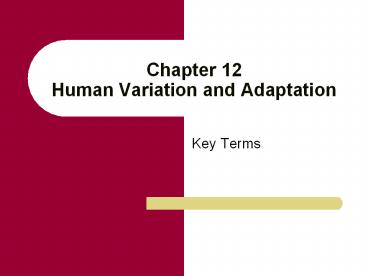Chapter 12 Human Variation and Adaptation - PowerPoint PPT Presentation
1 / 14
Title:
Chapter 12 Human Variation and Adaptation
Description:
Chapter 12 Human Variation and Adaptation Key Terms Chapter 12 Human Variation and Adaptation Key Terms Dolichocephalic Having a long, narrow head in which the width ... – PowerPoint PPT presentation
Number of Views:121
Avg rating:3.0/5.0
Title: Chapter 12 Human Variation and Adaptation
1
Chapter 12 Human Variation and Adaptation
- Key Terms
2
- DolichocephalicHaving a long, narrow head in
which the width measures less than 75 percent of
the length. - Brachycephalic Having a broad head in which the
width measures more than 80 percent of the length.
3
- Biological determinismThe concept that various
attributes and behaviors are governed by
biological (genetic) factors the inaccurate
association of behavioral attributes with certain
biological traits, such as skin color. - Eugenics Philosophy of race improvement
through forced sterilization of members of some
groups and encouraged reproduction among others
an overly simplified, often racist, view that is
now discredited.
4
- Polytypic Referring to species composed of
populations that differ with regard to the
expression of one or more traits. - Cline A gradual change in the frequency of
genotypes and phenotypes from one geographical
region to another.
5
- Population geneticists Geneticists who study the
frequencies of alleles, genotypes, and phenotypes
in populations. - Slash-and-burn agricultureA traditional
land-clearing practice whereby trees and
vegetation are cut and burned. In many areas,
fields are abandoned after a few years and
clearing occurs elsewhere.
6
- Balanced polymorphismThe maintenance of two or
more alleles in a population due to the selective
advantage of the heterozygote. - Lactose intolerance The inability to digest
fresh milk products, caused by the discontinued
production of lactase, the enzyme that breaks
down lactose, or milk sugar.
7
- Gene pool The total complement of genes shared
by reproductive members of a population. - Breeding isolates Populations that are clearly
isolated geographically and/or socially from
other breeding groups.
8
- Endogamy Mating with individuals from the same
group. - Exogamy Mating pattern whereby individuals
obtain mates from groups other than their own.
9
- Hardy-Weinberg theory of genetic equilibriumThe
mathematical relationship expressingunder ideal
conditionsthe predicted distribution of alleles
in populations the central theorem of population
genetics. - Population genetics A mathematical and
statistical approach used to measure and explain
evolutionary change in contemporary populations.
10
- Neural tube In early embryonic development, the
anatomical structure that develops to form the
brain and spinal cord. - Spina bifida A condition in which the arch of
one or several vertebrae fails to fuse and form a
protective barrier around the spinal cord.
11
- Vasodilation Expansion of blood vessels,
permitting increased blood flow to the skin.
Permits warming of the skin and facilitates
radiation of warmth as a means of cooling. An
involuntary response to warm temperatures,
various drugs, and even emotional states
(blushing). - VasoconstrictionNarrowing of blood vessels,
reducing blood flow to the skin. Vasoconstriction
is an involuntary response to cold and reduces
heat loss at the skins surface.
12
- Hypoxia Lack of oxygen. Hypoxia can refer to
reduced amounts of available oxygen in the
atmosphere (due to lowered barometric pressure)
or to insufficient amounts of oxygen in the
body. - Pathogens Substances or microorganisms, such as
bacteria, fungi, or viruses, that cause disease.
13
- Pandemic An extensive outbreak of disease
affecting large numbers of people over a wide
area potentially, a worldwide phenomenon. - Vectors Agents that transmit disease from one
carrier to another. Mosquitoes are vectors for
malaria, just as fleas are vectors for bubonic
plague.
14
- Endemic Continuously present in a population.































